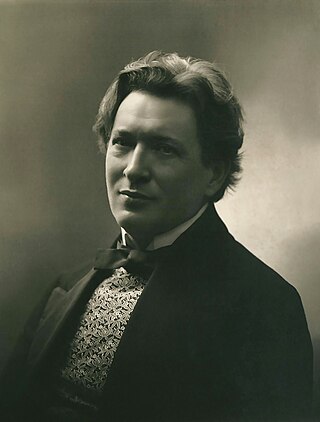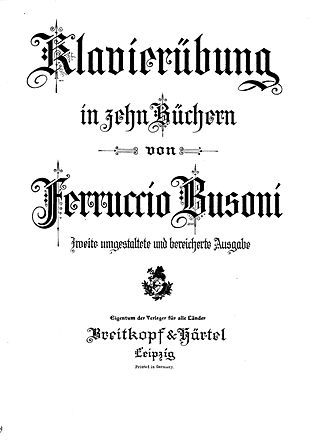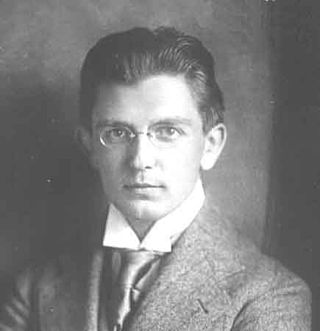| An die Jugend | |
|---|---|
| Solo piano pieces by Ferruccio Busoni | |
 The composer in 1906 | |
| Catalogue | BV 254 |
| Composed | 1909 |
An die Jugend(BV 254) is a sequence (or collection) of pieces of classical music for solo piano by Ferruccio Busoni.
| An die Jugend | |
|---|---|
| Solo piano pieces by Ferruccio Busoni | |
 The composer in 1906 | |
| Catalogue | BV 254 |
| Composed | 1909 |
An die Jugend(BV 254) is a sequence (or collection) of pieces of classical music for solo piano by Ferruccio Busoni.
The collection was written June–August 1909 and consists of four volumes, the last with an epilogue. It was published later in the same year by Zimmermann of Leipzig under four separate catalog numbers (Z 4755, Z 4756, Z 4757, and Z 4781). Each book takes about five minutes to play, and may be played separately, or together as a cycle. As in many other works by Busoni, it is compiled from transcribed, freely adapted, and original music. [1] [2]
The first performance, of Books 2, 3, and 4 (without "Epilogo"), was on 16 October 1909 in Bechstein Hall, London, with Busoni as the pianist. [4]
The materials of Book 1, and the "Epilogo," all related and highly original compositions, and written in the new style first explored in Elegien (BV 249), were later revised and combined with a new introduction and short linking passages presenting the thematic roots of the pieces and gluing them together into a single entity. The new piece, resembling a set of variations without a theme, Busoni entitled Sonatina (BV 257). This more advanced and forward-looking composition was the first of what would eventually be six "sonatinas" containing some of the most unusual and original piano music of the early 20th century. [2] [5]

Ferruccio Busoni was an Italian composer, pianist, conductor, editor, writer, and teacher. His international career and reputation led him to work closely with many of the leading musicians, artists and literary figures of his time, and he was a sought-after keyboard instructor and a teacher of composition.

Heinrich Schenker was a Galician-born Austrian music theorist whose writings have had a profound influence on subsequent musical analysis. His approach, now termed Schenkerian analysis, was most fully explained in a three-volume series, Neue musikalische Theorien und Phantasien, which included Harmony (1906), Counterpoint, and Free Composition (1935).
The Bach-Werke-Verzeichnis is a catalogue of compositions by Johann Sebastian Bach. It was first published in 1950, edited by Wolfgang Schmieder. The catalogue's second edition appeared in 1990. An abbreviated version of that second edition, known as BWV2a, was published in 1998.

The Toccata and Fugue in D minor, BWV 565, is a composition for organ by, according to the oldest sources, German composer Johann Sebastian Bach and is one of the most widely recognisable works in the organ repertoire. Although the date of its origin is unknown, scholars have suggested between 1704 and the 1750s. The piece opens with a toccata section followed by a fugue that ends in a coda, and is largely typical of the north German organ school of the Baroque era.

Opera in German is that of the German-speaking countries, which include Germany, Austria, and the historic German states that pre-date those countries.

The Fantasy on Themes from Mozart's Figaro and Don Giovanni, S.697, is an operatic paraphrase for solo piano by Franz Liszt, based on themes from two different Mozart's operas: The Marriage of Figaro, K.492 and Don Giovanni, K.527.

The sonatas and partitas for solo violin are a set of six works composed by Johann Sebastian Bach. They are sometimes referred to in English as the sonatas and partias for solo violin in accordance with Bach's headings in the autograph manuscript: "Partia" was commonly used in German-speaking regions during Bach's time, whereas the Italian "partita" was introduced to this set in the 1879 Bach Gesellschaft edition, having become standard by that time. The set consists of three sonatas da chiesa in four movements and three partitas in dance-form movements. The 2nd Partita is widely known for its Chaconne, considered one of the most masterly and expressive works ever written for solo violin.

Fantasia contrappuntistica(BV 256) is a solo piano piece composed by Ferruccio Busoni in 1910. Busoni created a number of versions of the work, including several for solo piano and one for two pianos. It has been arranged for organ and for orchestra under the composer's supervision.

The Piano Concerto in C major, Op. 39 (BV 247), by Ferruccio Busoni, is one of the largest works ever written in this genre. Completed and premiered in 1904, it is about 70 minutes long and laid out in five movements played without a break; in the final movement a quiet men's chorus intones words from the verse-drama Aladdin by Adam Oehlenschläger.

Ferruccio Busoni discography is a list of recordings of music composed or adapted by Ferruccio Busoni. For recordings of music with Busoni as pianist, see Ferruccio Busoni discography.

The Klavierübung, by the Italian pianist-composer Ferruccio Busoni, is a compilation of piano exercises and practice pieces, comprising transcriptions of works by other composers and original compositions of his own.

Elegies, BV 249, by the Italian composer Ferruccio Busoni is a set of solo piano pieces which can be played as a cycle or separately. Initially published in 1908 with six pieces, it was subsequently expanded to seven by the addition of the Berceuse. The set of seven takes just over 40 minutes to play.

The Bach-Busoni Editions are a series of publications by the Italian pianist-composer Ferruccio Busoni (1866–1924) containing primarily piano transcriptions of keyboard music by Johann Sebastian Bach. They also include performance suggestions, practice exercises, musical analysis, an essay on the art of transcribing Bach's organ music for piano, an analysis of the fugue from Beethoven's 'Hammerklavier' sonata, and other related material. The later editions also include free adaptations and original compositions by Busoni which are based on the music of Bach.

The Clavier-Übung III, sometimes referred to as the German Organ Mass, is a collection of compositions for organ by Johann Sebastian Bach, started in 1735–36 and published in 1739. It is considered Bach's most significant and extensive work for organ, containing some of his most musically complex and technically demanding compositions for that instrument.

Alfred Hoehn was a German pianist, composer, piano pedagogue and editor.